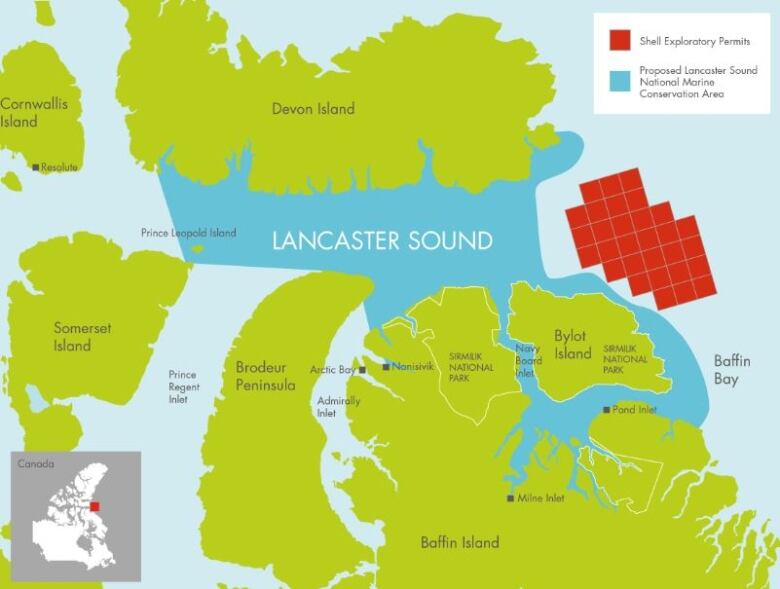Leases or not, Shell still leaves its mark on Lancaster Sound
Shell's legacy lives on in conservation area boundaries, writes the CBC's Jimmy Thomson
Shell Canada announced this week that it will relinquish its claim to 8,000 square kilometres of oil leases in the eastern Arctic amid public pressure and legal action. The move is garnering praise for the oil giant, with some saying the area is now available for protection.
But unless Parks Canada is going back to the drawing board with this new information in mind, the damage to that Arctic conservation proposal could already be done.

In the 1990s and early 2000swith the Nunavut government occupied with its land claims agreement and the establishment of the territorynot much progress was made, and the planning process finally resumed after the Harper government announced its intention to protect the area in a 2007 throne speech.
Throughout this process, Parks Canada determined that the area covered by Shell's leases must be excluded from protection, despite being located near the super-rich North Water Polynya, where narwhals, beluga whales and many other marine mammal and bird species migrate each year from all over the Canadian Arctic.
The result?A proposed eastern boundary to the conservation area that mirrors the shape of the oil leases, cutting into waters that otherwise could have been protected.

The oil leases were issued in 1971, and environmental groups have since argued that they expired eight years later and were never renewed. The World Wildlife Fund took Ottawa to court over the leases, in a lawsuit the Shell announcement renderedmoot.
About half of the area covered by the leases was identified by theQikiqtani Inuit Association as being in "very high" or "highest" need of protection.
In a report,QIA combined traditional ecological and historical knowledge, scientific knowledge, and high-resolution mapping to determine how well the proposed Parks Canada boundary overlapped with the most important areas to the Inuit. The grouphas proposed a boundary that is about twice as large as the Parks Canada boundary.
Records obtained by a Freedom of Information Request appear to show a 2014 meeting between Parks Canada planning officials, Shell Canada, and QIA representatives at Shell's Calgary office. In the meeting, Shell offers to give up its claim on the leases but says that the company "would need to get something back in return."
Whether or not that condition has been met is not yet known.
Not parks on water
National Marine Conservation Areas are not parks on water.

With the inclusion of the words "managed" and "used,"the National Marine Conservation Areas Act allows for shipping, hunting, fishing, and other industrial and commercial uses within its boundaries.Oil and gas extraction, however, is banned, as is seafloor mining.
Unlike international UNESCO designations, there are no requirements that activities that could pollute the inside of the NMCA be kept at a distance from the boundary. Therefore, the Shell leases never presented an obstacle to the creation of the NMCA, so long as the boundary wasdrawn to exclude them.
The Act does include a provision for enlarging NMCAs, and it's possible that even if the proposal goes ahead as it currently stands, the area could grow to encompass the Shell leases in the future.
Federal ministersstrongly hinted at that possibility while celebrating Shell's move to mark World Oceans Day in Ottawa Wednesday.
- WWF creates interactive map of Lancaster Sound in push for area's protection
- Shell leaving Lancaster Sound 'a relief' to Inuit, cynical ploy to Greenpeace
That would be a major win for the ecosystem.
Protecting the North Water Polynya would ensure that dozens of Arctic migratory species would have a year-round safe haven for the foreseeable future, andwith some of the best oil potential in the eastern Arctic protected, the likelihood of future drilling near the protected area would be drastically reduced.
For now, however, with the real jewel of the region left unprotected, the leases have left their mark.
Jimmy Thomson wrote his Master's thesison the Lancaster Sound NMCA at the University of British Columbia Graduate School of Journalism. That feature will be published in Maisonneuve Magazine's July issue. Jimmy recently joined CBC North, working out of Hay River, N.W.T.












_(720p).jpg)


 OFFICIAL HD MUSIC VIDEO.jpg)
.jpg)



























































































